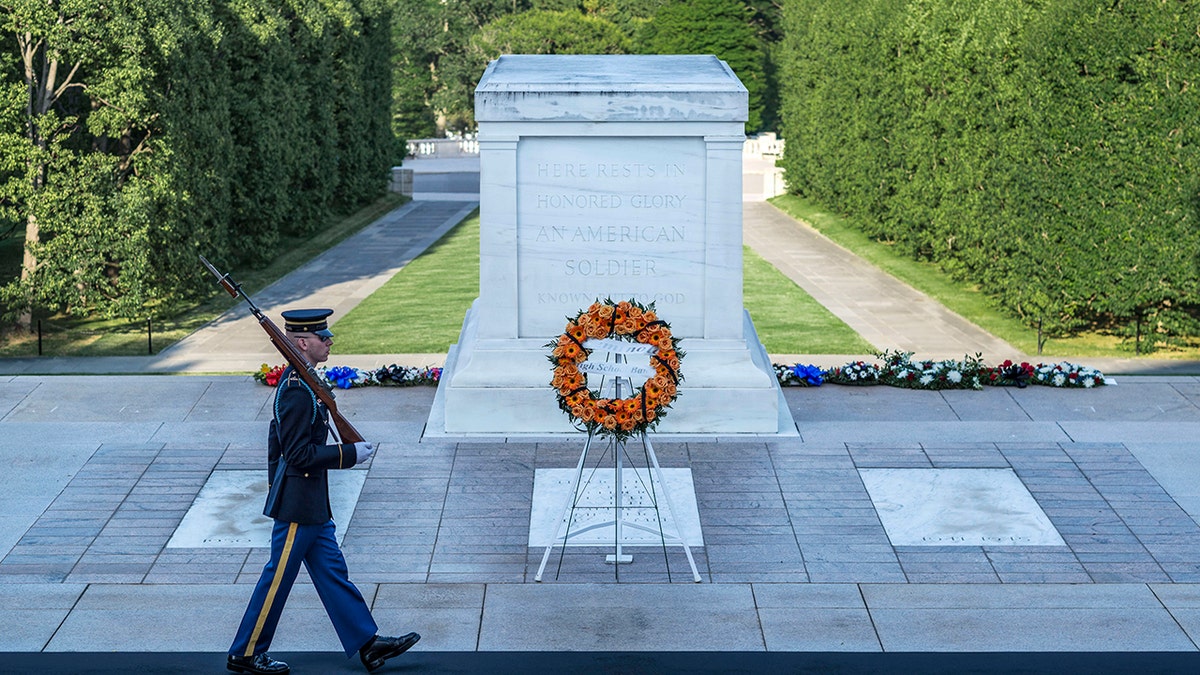
Guarded Tomb of the Unknown Soldier, Arlington Cemetery. (Photo by John Greim/LightRocket via Getty Images)
A group of homeschooled students from Virginia honored Medal of Honor recipient Fr. Emil Kapaun, a chaplain and Army captain in the Korean War, in a wreath-laying ceremony at the Tomb of the Unknown Soldier at Arlington National Cemetery on Wednesday, Nov. 1.
The children belong to Mary's House Homeschool Group, a group of more than 100 Catholic homeschooling families in Loudon and Fairfax counties. About 55 students affiliated with Mary's House attended Wednesday's ceremony.
The group's mission is to "support and encourage homeschool families as they raise their children in the Lord, so children are equipped to stand for the Lord and serve those around them — all while receiving a first-rate education."
BACK TO SCHOOL: TIPS FOR HOMESCHOOLING THE KIDS AS MORE PARENTS DITCH CLASSROOMS
Heather Ward, one of the original founding members of Mary's House, told Fox News Digital the group came together in 2004.
"It was nice to have that fellowship with fellow Catholic homeschoolers and just kind of have a support network," she said.
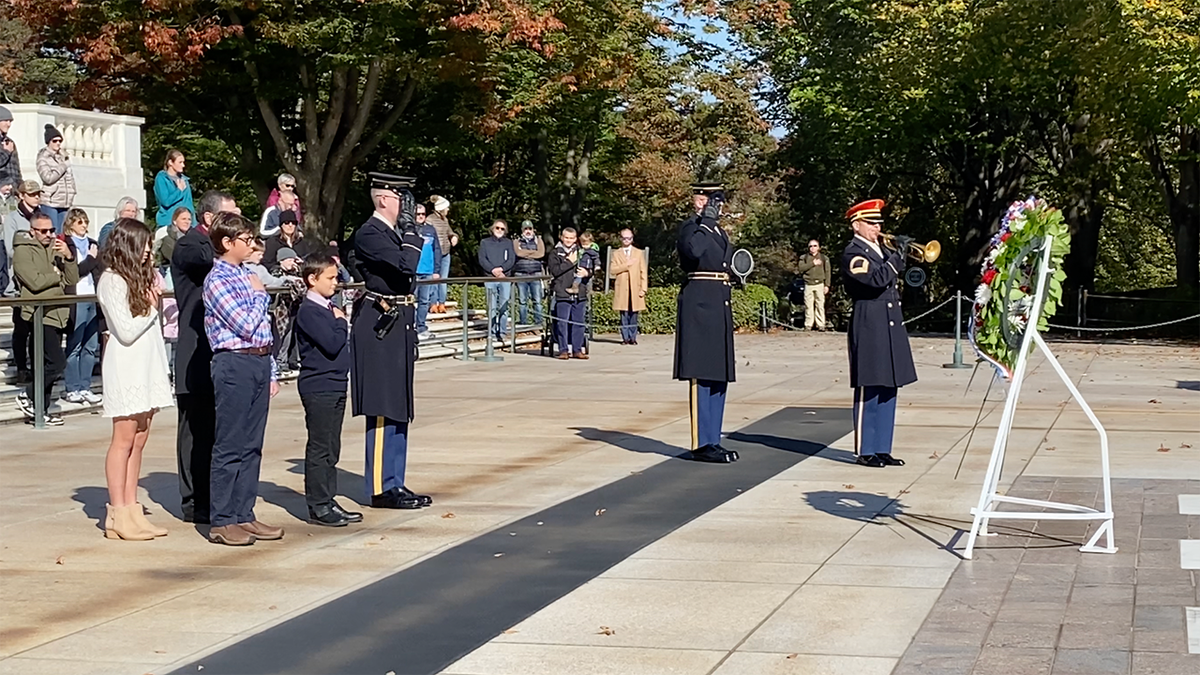
The three children at left won an essay writing contest in their homeschool group for the honor of laying a wreath at the Tomb of the Unknown Soldier at Arlington National Cemetery in memory of Army Chaplain Fr. Emil Kapaun. (Fox News Digital)
Ward, who lives in Sterling, Virginia, has four children — all of whom she homeschooled.
She said she was only vaguely familiar with the story of Fr. Kapaun before the event came together.
The three children who laid the wreath were winners of a group-wide essay contest about Fr. Kapaun's heroism and faithful fortitude.
"I felt special and honored to lay the wreath for the soldiers who died, unknown to the world, for our freedom."
Another mother in the group, said Ward, had the idea for the essay contest and the wreath-laying event.
"[The mother] came upon information about Fr. Kapaun and just thought it was so fascinating and so important for kids, because it's the juncture of God and country," said Ward.
She also said that Kapaun remains an excellent role model for young people — and she hopes they understand "the need to be selfless in our society, and also understanding that their freedoms [are] not free, that they were paid for by our veterans."

Mary's House, a homeschool group based in Virginia, laid a wreath in honor of Fr. Emil Kapaun at the Tomb of the Unknown Soldier at Arlington National Cemetery on Nov. 1, 2023. Fr. Kapaun received the Medal of Honor for an act of heroism on Nov. 1, 1950. (Fox News Digital)
"They need to honor them and those ideals," said Ward.
The three students, Luke, Isel and Henry (last names omitted for privacy), were escorted by Philip Collins, another Mary's House parent, combat Army veteran and member of the Knights of Columbus.
Henry, who is in sixth grade, told Fox News Digital that Kapaun "is an example to teach us that we should help others and share our faith with the world."
VETERANS DAY AND ITS HISTORY: 6 KEY FACTS TO KNOW
"I felt special and honored to lay the wreath for the soldiers who died, unknown to the world, for our freedom," he said.
"I also felt sad for them and their families when the bugle played, because I was thinking about all the fallen soldiers in WWI, WWII and the Korean War," he added.
Isel, an 8th grade student, told Fox News Digital that "it was a great honor to be able to lay a wreath in his memory" — and that the fallen priest "was a leader and a hero, an example to us all."
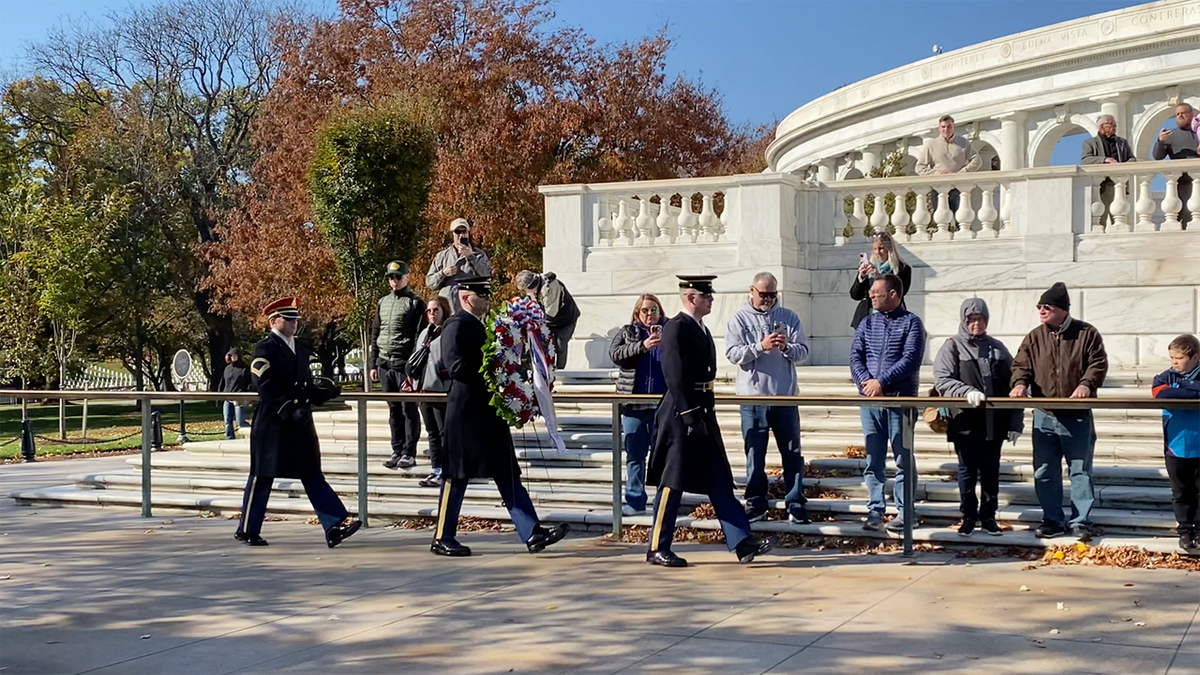
The wreath was brought to the Tomb of the Unknown Soldier at Arlington National Cemetery in Virginia by several guards. (Fox News Digital)
"Fr. Kapaun was a courageous man of God who led by example," Luke, a sixth grader, told Fox News Digital.
"He amazed me with his love for God and peace during challenging times," the student added. "The ceremony made me feel as if I were part of something bigger than myself."
Fr. Emil Kapaun was born on April 20, 1916, in Pilsen, Kansas.
ON MEMORIAL DAY, LEE GREENWOOD REMEMBERS AMERICA'S HEROES: 'NEVER TAKE FREEDOM FOR GRANTED'
He grew up on a farm — and was ordained a priest of the Diocese of Wichita on June 9, 1940, according to the diocesan website for his cause for canonization.
Four years later, he entered the U.S. Army Chaplain School at Ft. Devins, and was sent overseas.
He was promoted to captain in Jan. 1946. Kapaun re-enlisted in the Army in July 1946 and returned to active duty at Ft. Bliss in 1948, said the Diocese of Wichita.

Fr. Emil Kapaun, right, along with Capt. Jerome A. Dolan, left, helping an exhausted man, center, during the Korean War. In 2013, Kapaun was posthumously awarded the Medal of Honor. (Mike Hutmacher/Wichita Eagle/Tribune News Service via Getty Images)
In January 1950, Kapaun was once again sent overseas and arrived in Japan as a chaplain in the 8th Calvary Regiment, 1st Calvary Division.
The regiment was sent to Korea in July of that year.
Before he left for Korea, Kapaun sent a letter to his bishop back in Wichita.
"Tomorrow we are going into combat. I have everything in order, all Mass stipends, my will, etc.," wrote Kapaun. "The way the Catholic soldiers are rallying around the priest is edifying."
Kapaun was nearly killed several times, including once when his pipe was shot out of his mouth by a sniper.
In Korea, Kapaun was known for his fearlessness and his dedication to his faith — often celebrating Mass on the battlefield, sometimes using the hood of a Jeep as an altar, and praying with soldiers in foxholes, said the diocese.
The life of a chaplain in Korea was dangerous: Kapaun was nearly killed several times, including once when his pipe was shot out of his mouth by a sniper, says the diocesan website.
After an incident in which he lost all of his possessions — including his Jeep and his Mass kit — Kapaun began carrying the Blessed Sacrament and the items needed to celebrate Mass with him at all times, along with a confession stole and holy oils for anointing.
Kapaun's heroism on the battlefield did not go unnoticed. He was awarded the Bronze Star for his work in rescuing a wounded soldier amid heavy enemy fire. And while his actions were awarded and publicized, Kapaun — a humble man — wished that they were not.
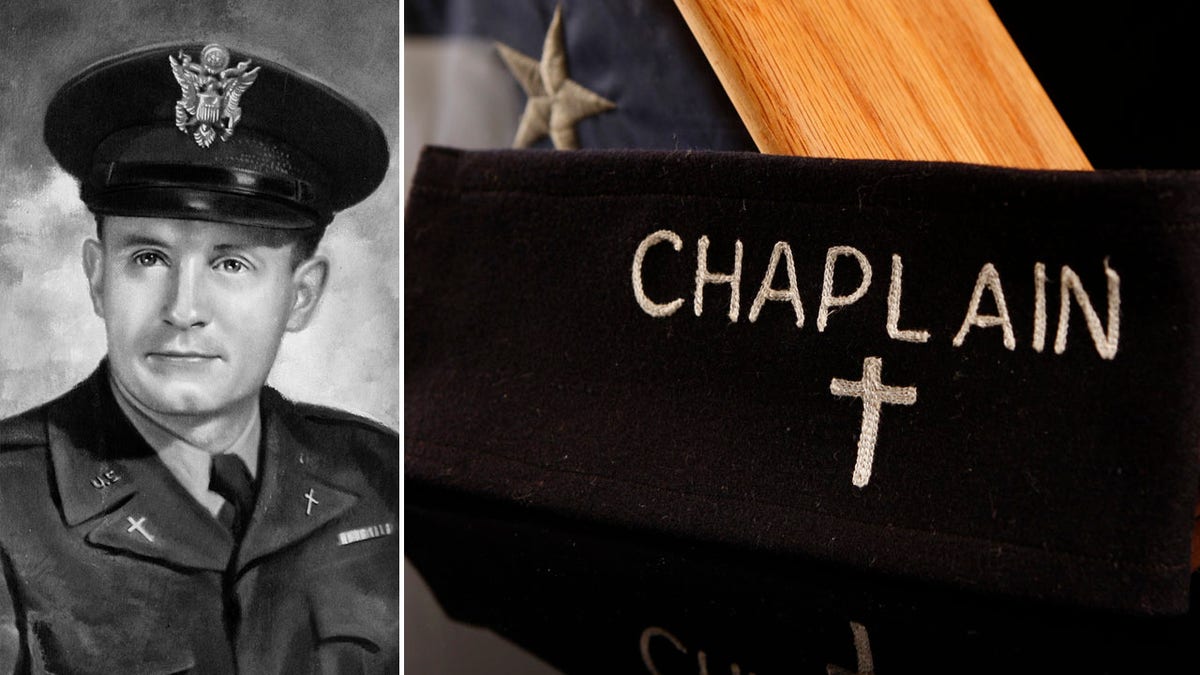
Ever the humble man, Fr. Kapaun was reportedly "less than thrilled" when news of his Bronze Star was reported in his hometown in Kansas. (U.S. Army/Getty Images)
Kapaun "was less than thrilled when he found out that news of this award was shared with the newspapers back home; to him, he was only doing what needed to be done," said the Diocese of Wichita.
On Nov. 1, 1950, Kapaun's regiment was attacked by the combined communist forces.
In an April 11, 2013, speech posthumously awarding the Medal of Honor to Kapaun, then-President Obama noted that there were "perhaps 20,000 soldiers pouring down on a few thousand Americans."
Added Obama, "In the chaos, dodging bullets and explosions, Fr. Kapaun raced between foxholes, out past the front lines and into no man’s land — dragging the wounded to safety."
Kapaun opted to stay on the battlefield even though his commanders ordered him to evacuate.
"He chose to stay — gathering the injured, tending to their wounds. When the enemy broke through and the combat was hand-to-hand, he carried on — comforting the injured and the dying, offering some measure of peace as they left this Earth," said Obama.
As the battle continued and "enemy forces bore down," it seemed as if more than a dozen American soldiers would be killed, the president continued.
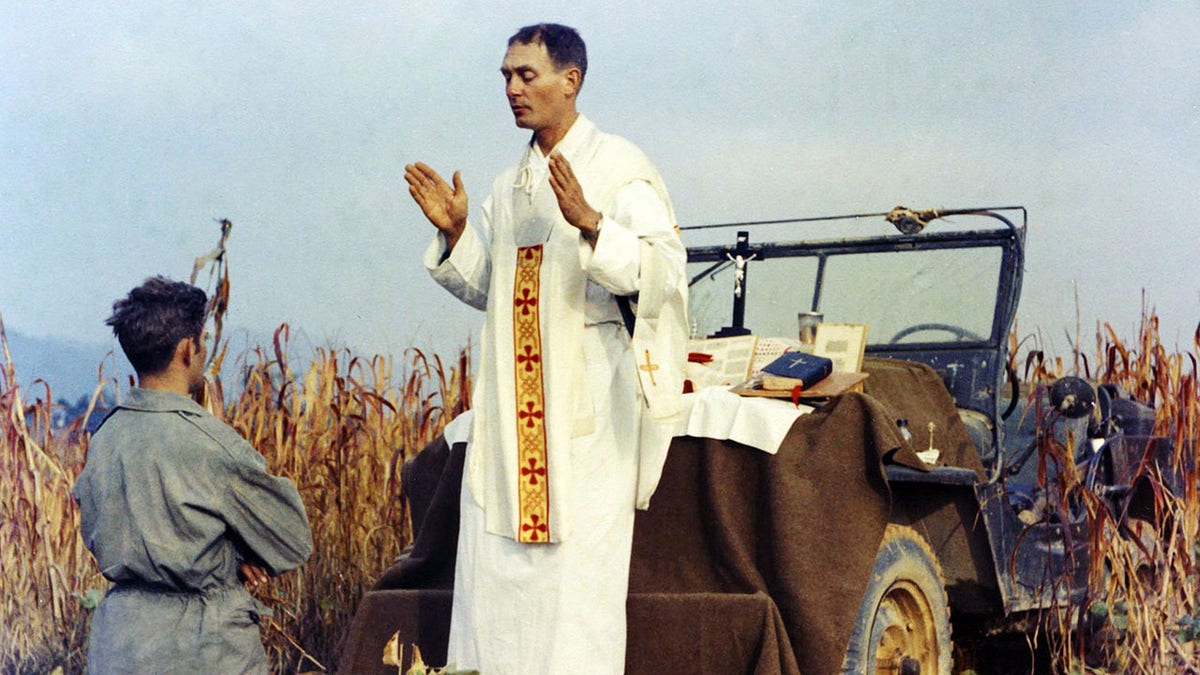
Fr. Emil Kapaun is shown celebrating Mass using the hood of his jeep as an altar, as his assistant, Patrick J. Schuler, kneels in prayer in Korea on Oct. 7, 1950, less than a month before Kapaun was taken prisoner. (U.S. Army Col. Raymond A. Skeehan/Courtesy of the Diocese of Wichita)
"But Fr. Kapaun spotted a wounded Chinese officer. He pleaded with this Chinese officer and convinced him to call out to his fellow Chinese," said Obama.
"The shooting stopped and they negotiated a safe surrender, saving those American lives."
Kapaun "wielded the mightiest weapon of all, a love for his brothers so pure that he was willing to die so that they might live."
Obama continued, "Then, as Fr. Kapaun was being led away, he saw another American — wounded, unable to walk, laying in a ditch, defenseless. An enemy soldier was standing over him, rifle aimed at his head, ready to shoot."
Kapaun, who did not carry a weapon, "marched over and pushed the enemy soldier aside. And then as the soldier watched, stunned, Fr. Kapaun carried that wounded American away."
Obama noted that while Kapaun was not armed in the traditional sense, he "wielded the mightiest weapon of all, a love for his brothers so pure that he was willing to die so that they might live."
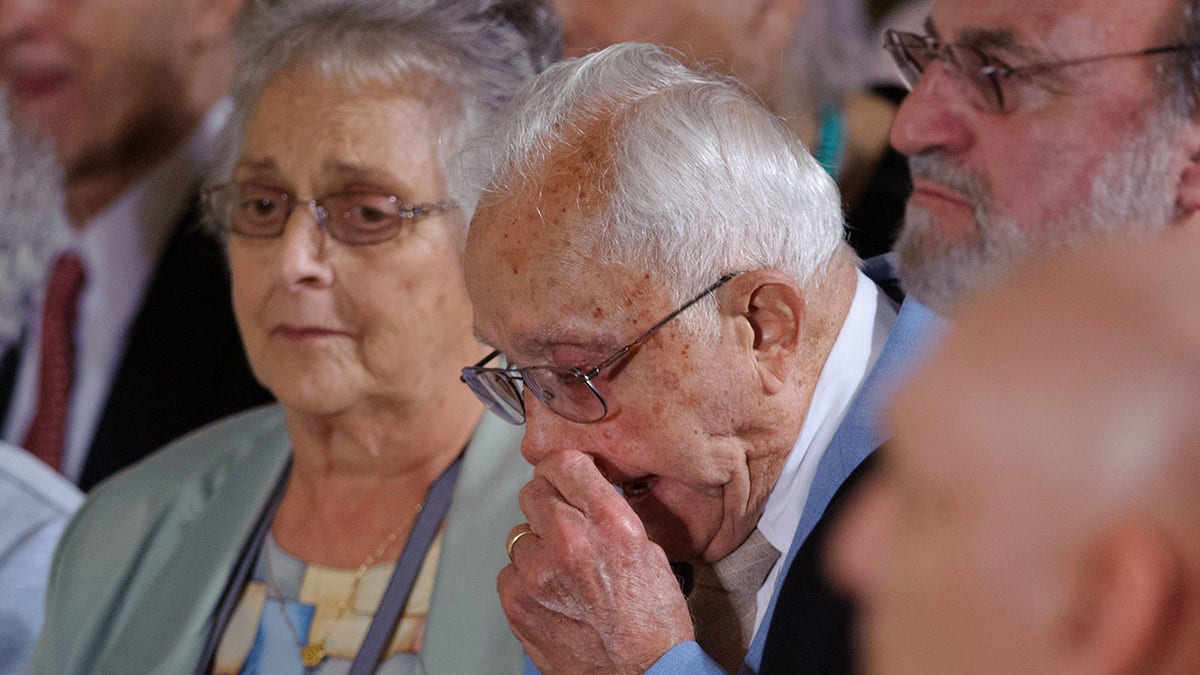
Herbert Miller, the man who was saved when Fr. Kapaun pushed an enemy soldier out of the way, wipes his face during a Medal of Honor ceremony for Kapaun on April 11, 2013, in the East Room of the White House in Washington, D.C. (MANDEL NGAN/AFP via Getty Images)
Captured once again by the communist forces, Kapaun and others were forced on a death march.
Kapaun continued carrying the wounded soldier he saved, and helped up other prisoners as they stumbled, Obama said in his speech.
Imprisoned in the Pyoktong prison camp, Kapaun would offer his clothes to others who were cold, encouraged fellow soldiers to not hoard their rations, and continued his work as a chaplain.
Despite a prohibition on prayer, plus constant mocking from the guards, Kapaun remained steadfast in his faith — reportedly leading his fellow prisoners in prayers for their captors.
His remains went unidentified for 70 years.
On Easter Sunday, he even managed to celebrate Mass, using materials he had kept hidden his entire time in captivity, noted Obama.
Kapaun eventually developed a blood clot and a myriad of other illnesses, and was taken to a "death house" at the prison camp.
CLICK HERE TO GET THE FOX NEWS APP
There, he died at age 35 on May 23, 1951.
His remains went unidentified for 70 years. In 1953, the remains of thousands of U.S. soldiers were returned to the United States as part of "Operation Glory," says the website for the Defense POW/MIA Accounting Agency.

Ray Kapaun, left, nephew of U.S. Army Chaplain Emil J. Kapaun, and President Barack Obama, right, after Kapaun was presented with his uncle's Medal of Honor for conspicuous gallantry, during an East Room Ceremony April 11, 2013, at the White House in Washington, D.C. (Alex Wong/Getty Images)
Kapaun's remains were among those sent to the United States, although technology did not exist at the time to identify his remains.
He, along with the remains of many other soldiers, had been buried as unknown soldiers at the National Cemetery of the Pacific in Hawaii.
After his remains were identified, they were returned to Kansas.
CLICK HERE TO SIGN UP FOR OUR LIFESTYLE NEWSLETTER
Kapaun is now interred at the Cathedral of the Immaculate Conception in Wichita.
He was named a "Servant of God" in 1993. His cause for canonization was opened in June 2008.
For more Lifestyle articles, visit www.foxnews.com/lifestyle.



















